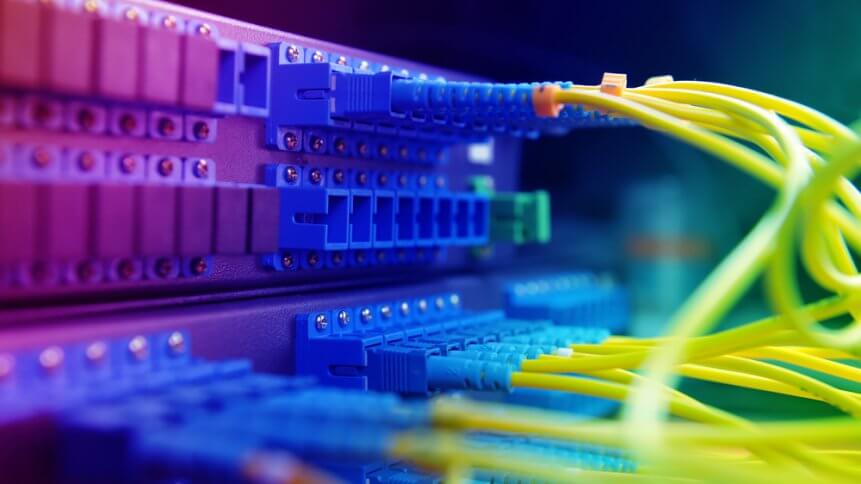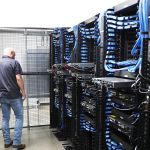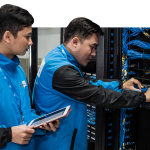The new generation of data centers are automated and self-managing

- The workflow of data centers are disrupted by lockdown restrictions
- Companies are looking to public cloud solutions to cope with the rising demand from work-from-home users
- Automation and AI tools are the major drivers of upcoming data centers
In the thick of the pandemic, TechHQ covered the story of the unsung heroes of the tech world — data center workers.
Stringent lockdown measures have impacted the daily workflow of various businesses, and only key essential workers are given the green light to offices and other facilities.
Ambiguity arises when contract data center workers are not given the same ‘pass’ for movement. Yet these operators and contractors are the front liners when it comes to maintaining and keeping data centers running.
In this light, the significant role of data centers is highlighted more than ever, and some trends are spotted to take shape due to the unique challenges brought upon by the pandemic.
To understand the impact of COVID-19 and remote working on the evolution of the data centers, TechHQ interviewed Lenovo DCG’s APAC Director for Software Defined Infrastructure, Kumara Raghavan.
In the past, data center administrators would have to schedule downtime during the weekends and be on standby to do upgrades and updates when the power users were using the mainstream applications. Raghavan added those were the norms “by and large, especially if you have a quality hyper converged infrastructure and software combination.”
In today’s climate, recurring themes Raghavan noted were automation and self-managing tech in data centers that minimize the reliance of human workers being physically present all the time.
“We have administrators who do their firmware updates while doing their shopping — it’s a one click upgrade.
“That’s just an example of the various levels of automation that has crept into the data centers,” he said.
Besides that, for companies with hybrid cloud, they are able to preset the provisioning for servers and applications when a spike occurs. Citing it as a result of automation and scripting, Raghavan shared that this is the reality for companies with a high degree of resilience due to the increasing level of automation baked into their data centers.
Furthermore, Raghavan shared that companies are focused on balancing the workload of data servers by diversifying their traffic through multiple data centers across specific geographical regions. In light of the pandemic, another consideration for companies would be to fulfill the demand of a rise in number of employees working from home.
These may be some of the general trends that are observed, but the decision and evolving role of data center management are dependent on a company’s available resources, budgets, purposes, and essentially, experience with the cloud and data centers.
Raghavan explained there are two kinds of behaviors that are driving the way companies manage their data centers in the current environment.
For companies that are still at the early stages of digital transformation, they are most likely to pivot as they face the drastic surge in work from home capacity requirements.
The heightened demand includes the need for extra bandwidth, more compute power or storage but without change to existing budgets. Hence, companies have to rethink how to best cater to these growing needs without completely blowing out on their cash reserves.
“Once, they have planned their own transformation, I think it’s easy for them to move capacity and that is one of the facilities that come from the principle of the hybrid cloud,” Raghavan shared.
As for companies that didn’t have the full capacity or are inadequately prepared for upheaval times of the pandemic, opening up capability on public clouds seems a viable solution. Raghavan noted companies aiming for “want an immediate fix to their problems and are looking to public cloud.”
Despite the spike of interest in public cloud as a temporary relief, Raghavan said “we don’t see this as a permanent move.”
“I think the underlying concerns of why everything has not shifted to public cloud, contrary to some expectations, haven’t really gone away,” he said.
Some of the considerations impeding mass migration to public cloud relate to the control of data and costs. In the short term, a monthly bill, as opposed to a single capital expenditure, may be a more feasible option for companies but in the long run, the cost proves to be quite expensive.
Raghavan also pointed out the aspect of latency in public cloud as a factor to the trend not taking off, “especially in today’s environment that there is so much demand on the network.”
YOU MIGHT LIKE

Data center workers — the unsung ‘essential workforce’
In sum, “we see some temporary increase in the public cloud utilization, but in reality, customers are now thinking through accelerating their digital transformation […] and we see that they have better management of the workflow.”
In essence, the management of data centers is noted to be influenced by emerging technologies such as the cloud, edge, and artificial intelligence (AI).
Raghavan shared that the AI tools related to common management will gain prominence.
Besides that, edge devices have the potential to help companies monitor and manage different zones of data centers. For instance, companies can change the settings of data center cooling based on the volume of workload, potentially saving huge amounts of costs spend on cooling and driving efficiency. The key is to “try and reduce the dependency on humans when it comes to intervening and that happens within typical servers,” said Raghavan.
Adding to the mix, self-managing technologies and predictive technologies will be major players in the space. Cutting-edge technologies will be able to monitor a range of parameters of drives. For instance, algorithms can track the performance of disks and predict with a fair amount of accuracy in the malfunction of it. By doing so, data center administrators are alerted of possible failures and are able to act in a swift manner, minimizing disruption.
In sum, the utilization of AI tools in data centers may not be scaled completely and widely in the discussed level but it does indicate the direction data center management is heading.









